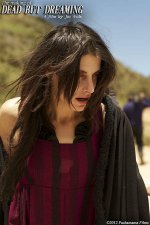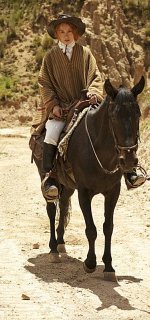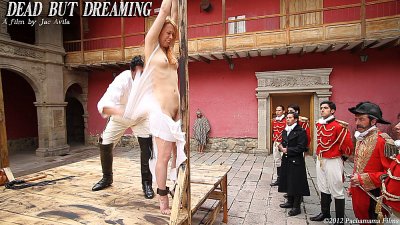|
You are very hesitant to give away too much about your upcoming film
Dead But Dreaming - so, what can you tell us about it yet?
I see Dead But Dreaming as an Aristotelian epic. A low
budget epic, but an epic nevertheless. Yes, Iím hesitant at
this point in the production to go into details, but what I can say is
that the film follows the conflictive story of a few intriguing characters
through the ages. Itís a fantasy/horror film about some
people that drink blood to survive and live a long, very, very long time
if theyíre not killed, that is. Itís something like Jean
Rollin meets Hammer Films meets
True Blood, with lots more blood, sex,
torture, violence and nudity.
There you have it, the big revelation. Dead But Dreaming
is a Vampyre movie epic. What
were some of your inspirations for Dead But Dreaming, and how did
the project get off the ground?
I had the
original idea for this movie a very long time ago. I wrote
a script tailored to Carmen Paintoux, the lead actress in Martyr, and
Veronica, the leading lady in SirwiŮakuy.
I did a
couple of rehearsal scenes with them and they were awesome, but I
didnít have the funds back then, and the technology was not where it
is today, that was in the 90ís, thus the story was shelved for all
this time. I tried to revive it a few times but I kept
running into mental, creative and financial blocks. As time
went by it was fairly obvious to me that the story could no longer be
made as originally concieved. Carmen and Veronica were no longer in
their late teens, early twentiesÖ So, I had to change the story,
keeping the spirit, but almost everything else had to go. Which
was very difficult, I was in love with the original script.
After the
release of Maleficarum, we found ourselves with some extra funds for
production and, in addition, an extremely nice person, who loved what we
did with the inquisition film, wanted to contribute to our next
production.
However,
what closed the deal for this project was that Veronica, who is vital
for the story, was available and willing to come all the way from France
right away, so it was obvious that I was finally ready to shoot this
film. Everything just fell into place.
As I understand, the
film is still in production. So how far along is it, and what can you tell
us about the actual shoot so far?
Weíre half
way there. We shot almost half of the movie. All
of the parts involving Veronica are in the can, so she went back home to
France and weíre shooting the rest of the movie.
We completed
some of the most difficult scenes before Veronica left and before Amy
Hesketh [Amy Hesketh interview
- click here] had to go to New York for a few days. One sequence involved three days
of shooting at a museum where we had a public flogging and execution.
Another sequence takes place in the Island of the Sun, in the
middle of the Titikaka Lake. It was very hard to get to that far off
location with all our cast, crew and equipment. We hired a
minibus that broke down on the highway, we had to wait for a
replacement. After reaching the shores of the lake, many
hours later, we had to cross the Tiquina channel in a boat, then take
the minibus again to Copacabana and from there we took a boat for a
three hour ride to the island.
Apart from
those two difficult locations and scenes, everything else is going
smoothly, which doesnít mean that we donít have a lot of difficult
scenes in the future.
From what I can make
out from the stills available, Dead But Dreaming seems to jump
around between quite a few different time periods to tell its story. Why,
and how much of a challenge is that production-wise, especially on a low budget?
This is a
very ambitious project. Every time I described a scene to
Amy, whoís producing the film with me, I sent her into shock. And
I still do. However, she takes the challenge and here we are, producing
the most difficult film I ever made.
Iíd love
to travel in time. If that option was at all possible I
would definitely book a few trips. Since I canít do it
for real, I do the next best thing; I create a past for my amusement.
To tell this
story I have to go into why certain characters are the way they are and
how that came to be and the only way to do that in an interesting,
captivating way is to travel back in time. Iím not very
fond of telling that part of the story with a narration track.
Itís a
challenge, of course, especially since Iím recreating periods that are
far apart both in time and space. One period of time is
around 10,000 BC, in the Andes, in an area that it is believed was the
site of the mysterious Atlantida in a period of time we know very little
about but which is very important for my story. In this
part of the movie I go into mythology, but a mythology that I create,
including a couple of languages that in the story become the root of
later languages.
Another
period is Greece circa 57 BC, which we know a lot more about, but
without travelling to Greece. Here I looked into the old
Greek dramas and mythology to develop the script by taking a fragment of
an old story.
From 57 BC I
jump into the 1800ís, when South America was at the beginning of its
wars for independence from Spain. I place the story in a
historical context.
Later on I
go into France in 1944, during WWII but only for a short scene involving
the liberation of a French town from the Nazis and a Gestapo dungeon.
Finally I go
to more contemporary times where I deal with authoritarian dictators,
plots to control the economic base of some country etc, but all
within the main story, the one that begins more than 10,000 years
before.
The hardest
part in the production is finding or making the costumes, but luckily we
found that some institutions are very helpful. We even got
the actual uniform of a national hero from the 1800s to dress our
Governor. Along with the antique uniform we got antique
weapons, more uniforms, really cool.
The
locations are not hard to find, we are surrounded by them, some have
easy access, some donít, but they are all available for me. One
difficult part is the sound. Weíre in a big city that has
the nastiest sound pollution you can find. Drivers are in
love with their horns, demonstrators are in love with their fireworks,
and pirate music vendors have their speakers so loud they make the city
tremble. Avoiding or ignoring that awful city noise is a
big task. We canít have ambiance sound of trucks and
ambulances in the 1800ís.
We managed
to shoot Maleficarum with less than half the budget we have for
Dead But Dreaming, so we feel that we can make pull this new film with what we
have. If thereís something I have it is experience in
working with micro or no budgets.
To
turn the last question on its head: As a director, do you feel any kind of
special stimulation in filming a period piece?
I love the challenge, for one. The stories I have in mind
make sense if they happen a while back. Iím more
comfortable telling violent, sadistic stories when Iím removed from
its reality by a few hundred years.
I also delve into fantasy, the images that old tales, history, provide
to us. Itís all stimulating to me. The nasty parts of
history have an appeal to me and apparently to a lot of other people who
are becoming our very own, growing fan base.
What can
you tell us about your overall directorial approach to Dead But Dreaming?
I have some very difficult scenes in Dead But Dreaming. I
have to deal with large numbers of people in locations where I donít
have 100 percent of control. So I have to work around that.
A lot of the people Iím working with donít have a lot of
experience, so I have to be very, very precise in what I ask them to do.
I canít expect a lot of them to take the initiative, to create
their characters from scratch, to bring something they can see into
them. It all has to come from me.
But to
counteract these shortcomings Iím working with my very talented bunch
of actors and a small crew of very experienced people so I know what to
expect from them and I can relax a bit.
What I
donít do is ask from people what they cannot give. Iím
very intuitive in that sense. I donít waste time trying
to force a cube into a round hole.

Veronica Paintoux |
I immensely
rely on the experience and amazing talent of my leading ladies,
particularly Amy who, so far, had the hardest job in this movie. The
hard part for me is to make sure I go as far as possible with the scenes
without pushing my leading ladies too far. They have a hard
job and Iím most concerned for their wellbeing.
|

Amy Hesketh |
Your three leading ladies, Veronica
Paintoux, Amy Hesketh [Amy Hesketh
interview - click here] and Mila Joya, are all no strangers to
your films. What draws them back to you/draws you back to them, and what
are your collaborations usually like?
With Vero,
Amy and Mila thereís a lot of trust. I know how far they
are willing to go and they know how much I can ask from them. I
love working with them, Iím very, very comfortable and they feel
comfortable as well.
And itís
interesting to see how they make everyone else feel comfortable in
scenes that are very hard to shoot. We had a scene in which
Amy was raped by four soldiers. Only one of the actors had
experience working in something like that with us, the torturer-rapist
in Maleficarum. The other three were neophytes. But
Amy made them feel comfortable in being absolutely horrendous to her.
In the scene sheís practically naked and the soldiers take
turns, encouraging each other, teasing each other, laughing, while Amy
is crying her heart out, unable to fight back. It was
terribly uncomfortable for me. It was certainly extremely tough for Amy,
and truly awkward for the actors playing the rapist soldiers. Itís
hard for an actor to play a role where he becomes the epitome of evil.
 |
When we shot
the public flogging scene Amy was naked most of the time and she was
making all the extras, who had never seen anything like it, feel very,
very comfortable with the situation. She makes
jokes, not showing her discomfort when weíre not shooting, she manages
to dispell the tension. Sheís a good sport and makes everyone else
feel like itís a fun time, even if itís not for her. Itís the
same with Vero or Mila, they make everyone feel fine when the situation
is actually very difficult for them and hard to watch.
When we were
shooting at the Island of the Sun there were tons of tourists walking
around. Thereís a bloody scene where Vero is naked and
covered in blood. But it has a twist. We were
shooting that scene and many of the tourists were watching, when the
twist came they broke into a big ovation and cheers, it was fun.
Obviously,
what draws me back to them time and time again is their tremendous
talent and their beauty and the fact that we all work together well.
What draws them back to me?Ö I donít know, I must be
extremely charming, but I wouldnít know.
You have also cast
yourself in Dead But Dreaming
right? Without giving away too much,
could you talk about your role for a bit, and why you chose exactly that
role for yourself?
Originally
my role was tiny. I appeared at the beginning of the story,
to justify the existence of Veroís character and then I would
re-appear at the end. One reason was that I kind of look
like the ďhistoricalĒ character I had in mind for this role and I
had a very specific way I wanted him to be. But when I
was reworking the script I found the character sneaking in all over the
place as if he wanted to be more important, or something, soÖ there I
am now, but Iím no longer that Ďhistoricalí character I was basing
the role on, but someone completely different. I was even
tempted to cast someone else for the part, but I didnít find anybody
with my devilish charm and looks.
When I
choose a role for myself I make one that I will feel fine doing. Directing
and acting at the same time is complicated, so I canít give myself a
role as complex as the one I played in Barbazul in which I was directed
by Amy.
In this role
I play against Mila and Amy, most of the time, I start with Vero, with
whom I have a short and nasty exchange but after that scene is over I
donít see her anymore, in the movie, and she becomes my obsession for
the ages. Most of the
time Iím on screen Iím with either Mila or Amy or both and they take
a lot of the attention away from me. That makes things
easier and cool.
What can you tell us about the rest
of your cast and crew?
I have an ensemble of actors we worked with in Maleficarum and
Barbazul,
and in addition I called in Jorge Ortiz, a well-known Bolivian actor who
never worked with me before. They all do an excellent job.
My crew is small, the same crew I worked with in Maleficarum
with one
addition, a make up artist. The director of Photography,
Miguel, is my most important collaborator because he gives the film the
look it will have. And of course I have Amy as producer and animal
handler (me, not the horse) and she makes sure I direct well and that
everyone is doing their job and sometimes, when Iím acting, she kind
of directs the scene.
Your last two films, Martyr
and Maleficarum, featured
quite a bit of torture and the like. Is there anything comparable to that in
Dead But Dreaming?
Well, not as
much as in Maleficarum, but more than in
Martyr. The
torture and violent scenes in Dead But Dreaming
are pretty nasty but
never comparable to what I did in Maleficarum. Although
they stand on their own.
Martyr was a
more personal film. The torture was sought out by the main
character, Camille, who made everyone around her play a role in her
passion. Camilleís sought after suffering IS the story. In Maleficarum, we have an inquisitor who goes out of his way to make
things bad for Mariana and Francisca, the accused witches. His
methods are extreme and thatís the focus of the story.
In Dead But Dreaming
the torture is not the story, itís a big part of it, but
itís not the theme. Thatís one basic difference.
The $64-question of course: Is there
any even tentative release date set yet? No. We havenít
considered that yet. Weíll be done shooting at the end of
March, I think. If it works out like Maleficarum, itís
possible that weíll have the film ready at the end of October, but
weíre not expecting to release this film until early next year. Any future
projects beyond Dead But Dreaming? Amy is preparing
a couple of scripts that weíre going to shoot this year and Iím
totally committed to this project which, in fact, is not just ONE movie,
itís two, so far, and if Veronica returns in September, as weíre
negotiating, it may be a three part story and if the story holds, there
might even be a part IV Ö thatís why I started by saying Dead But Dreaming
is an Aristotelian Vampyre Epic. It can go on, and
on.
 |
Feeling lucky?
Want to
search
any of my partnershops yourself
for more, better results?
(commissions earned) |
The links below
will take you
just there!!!
|
|
 |
Your/your
movies website, Facebook, whatever else?
http://pachamamafilms.com
http://vermeerworks.com
https://www.facebook.com/jac.avila
https://www.facebook.com/deadbutdreamingmovie
http://jacavila.blogspot.com/
http://amyhesketh.blogspot.com/
Anything else
you are dying to mention and have merely forgotten to ask?
Weíre on a roll, a lot is happening around our work. SirwiŮakuy
was invited to participate in a festival in New York, CineKink 2012,
where it was received with a lot of enthusiasm by the audience, Amy was
called a ďvisual geniusĒ. In the meantime, here, in
Bolivia, Maleficarum
was censored by the Cinemateca. The
strange thing is that a film like L.A. Zombie played there and Maleficarum
was censored. We donít understand that.
The stated reason for not showing Maleficarum
is: ďit has
explicit languageĒ - we donít
know what it means. Itís a lame excuse.
The films I
make are very explicit, as you know. I donít limit myself
to suggest something. I show it, the way it is or was or
the way I think it is. So, if Maleficarum
was censored,
itís easy to guess that Dead But Dreaming
will be censored too. On
the other hand if Dead But Dreaming
is as successful as Maleficarum,
then weíll have a winner.
Thanks for the interview!
Thank you
for the opportunity to spread the news.
|